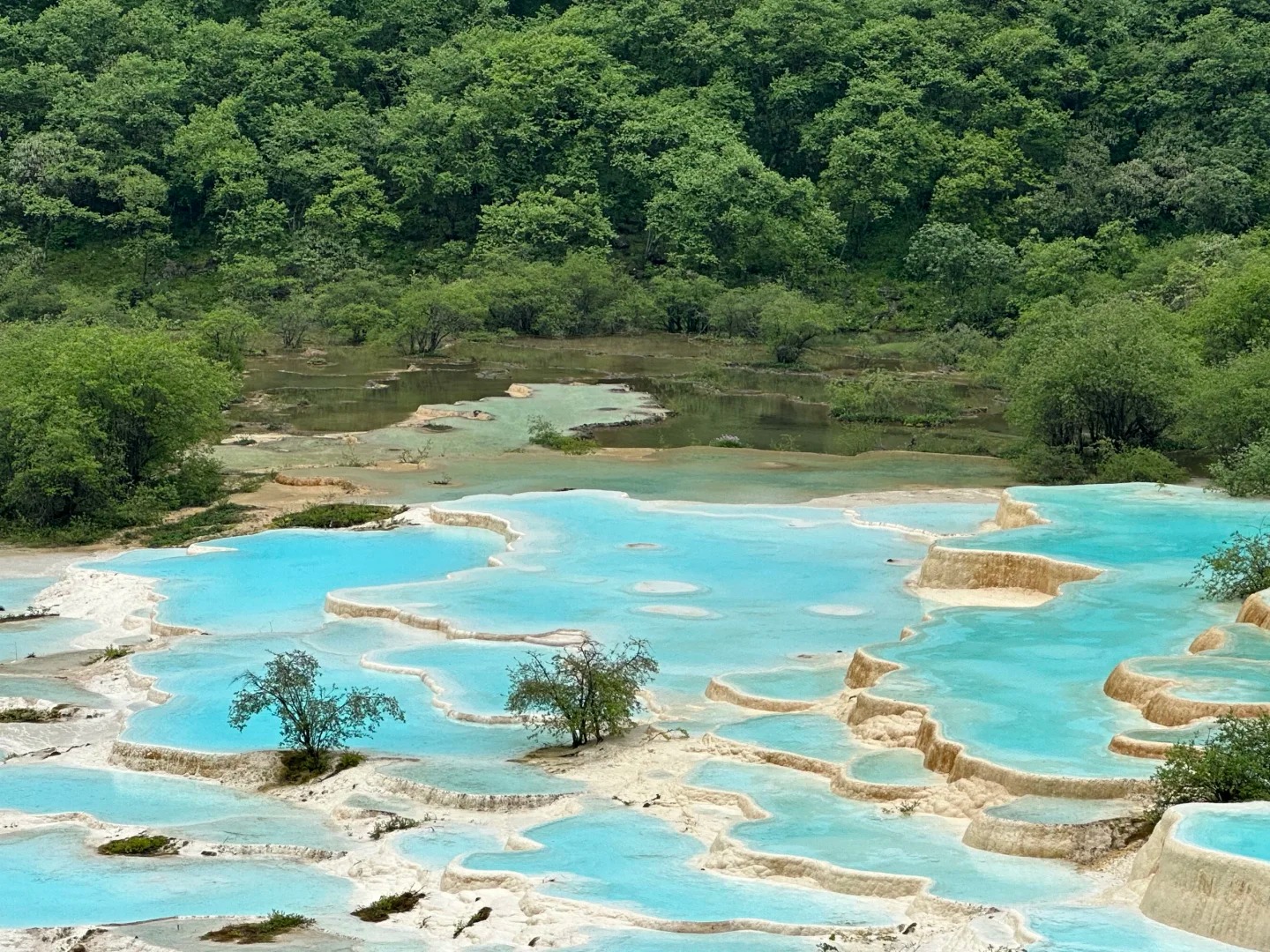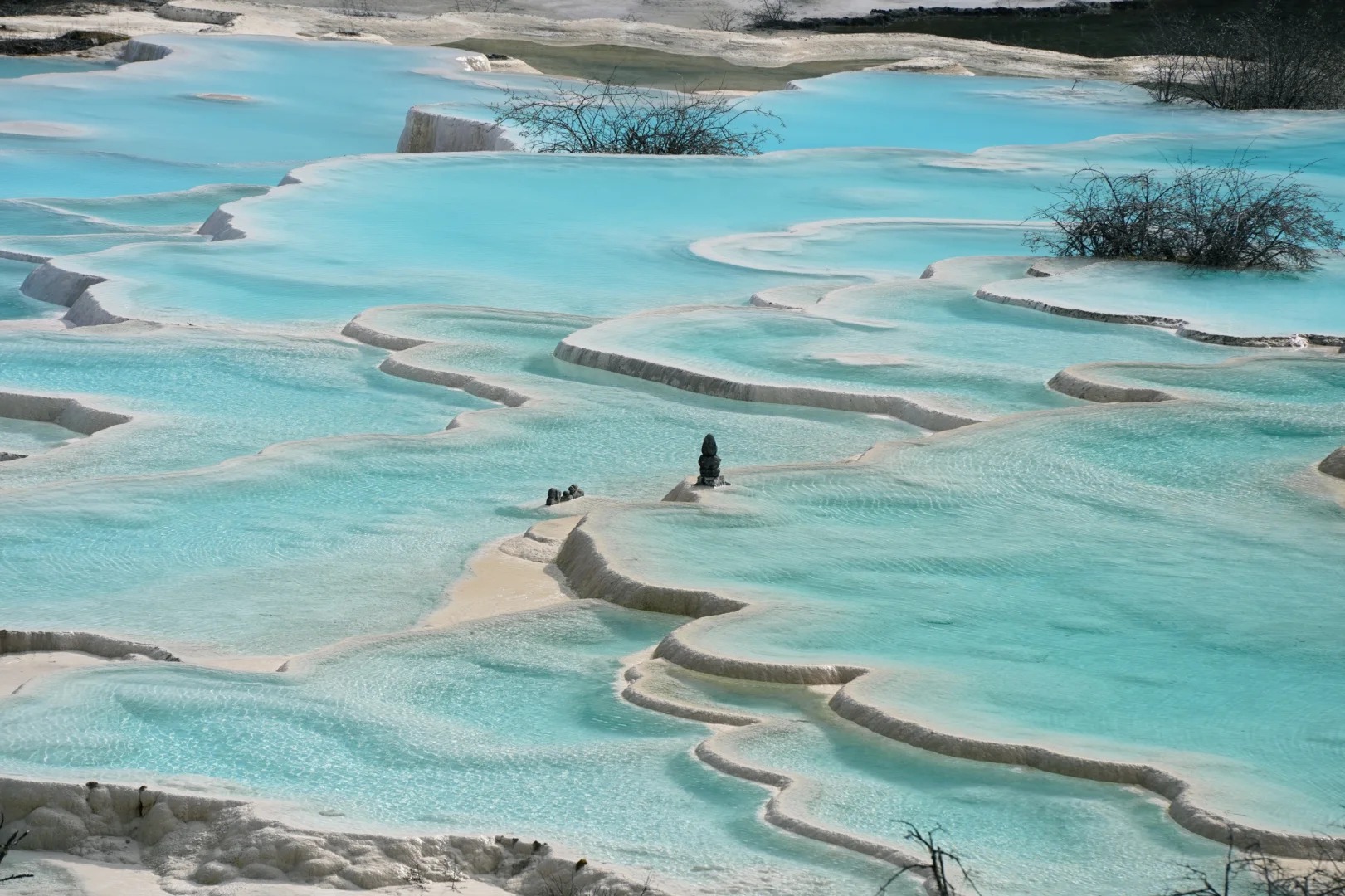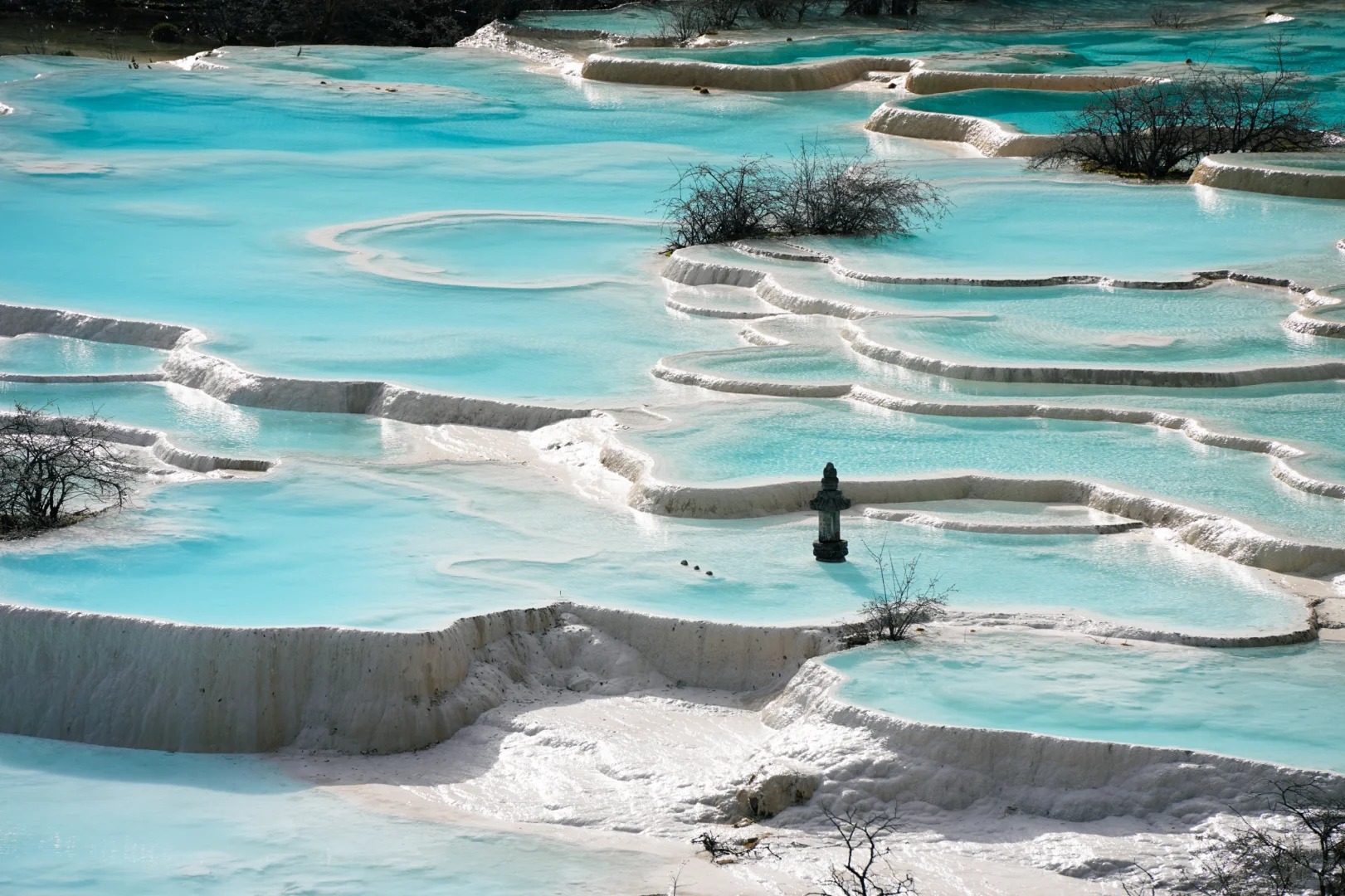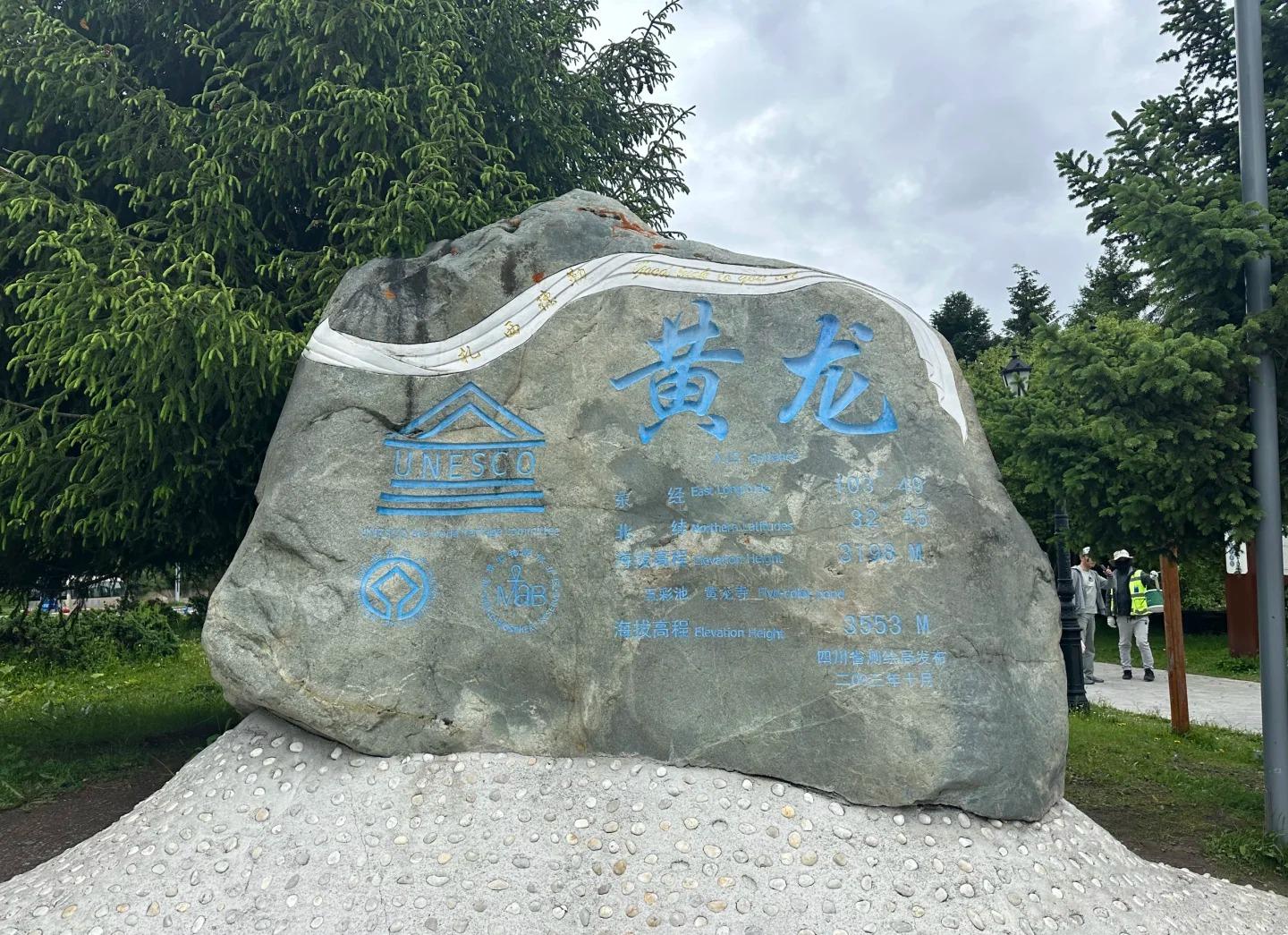Introduction to Yellow Dragon
Nestled in the Minshan Mountains of Sichuan Province, Yellow Dragon (黄龙, Huánglong) is a natural wonder that captivates visitors with its otherworldly beauty. Recognized as a UNESCO World Heritage Site in 1992, this scenic area spans over 700 square kilometers of breathtaking landscapes, featuring colorful travertine pools, snow-capped peaks, and diverse ecosystems.
| Yellow Dragon at a Glance | |
|---|---|
| Location | Songpan County, Sichuan Province |
| Elevation | 3,000 – 3,600 meters above sea level |
| UNESCO inscription | 1992 |
| Notable feature | Travertine pools |
Geological Wonders
Travertine Pools: Nature’s Palette
The heart of Yellow Dragon’s allure lies in its spectacular travertine pools. Formed over millennia by calcite deposits, these terraced pools create a mesmerizing landscape that seems to flow down the mountainside like a golden dragon’s scales – hence the area’s poetic name.
The Golden Sand Beach
At the valley’s end, visitors encounter the “Golden Sand Beach,” a vast expanse of yellow travertine that shimmers like golden sand under the sunlight. This unique geological formation is the result of mineral-rich water flowing over limestone, creating a surreal, desert-like landscape amidst the surrounding greenery.

Biodiversity and Ecosystems
Yellow Dragon’s varied altitude and climate foster a rich tapestry of life:
- Alpine Forests: Home to ancient spruce, fir, and cypress trees
- Meadows: Burst with colorful wildflowers in summer
- Wildlife: Sanctuary for endangered species like the Giant Panda and Golden Snub-nosed Monkey
The area’s biodiversity is a testament to the delicate balance of nature, with each species playing a crucial role in the ecosystem’s health.

Cultural Significance
Yellow Dragon is not just a natural wonder but also a cultural crossroads. The region has been shaped by Tibetan and Qiang influences, evident in local customs, architecture, and spiritual practices.
Legends and Myths
Local folklore speaks of a yellow dragon who created the landscape:
- The dragon’s scales became the colorful pools
- Its horn transformed into the snowy peaks
- Its spirit imbued the land with sacred energy
Religious Sites
The Yellow Dragon Temple, perched at 3,600 meters, offers a glimpse into the area’s spiritual significance. Buddhist pilgrims have revered this site for centuries, believing it to be a gateway to enlightenment.

Top Attractions and Hiking Trails
| Attraction | Description |
|---|---|
| Multi-colored Ponds | A 3.6-kilometer boardwalk meanders through over 600 vibrantly hued pools |
| Five-Color Pond | The crown jewel, showcasing a stunning array of blues, greens, and yellows |
| Xishen Cave Waterfalls | A series of cascades emerging from mysterious caves |
| Rhinoceros Lake | A serene alpine lake surrounded by lush forests |
Hiking enthusiasts can explore well-maintained trails that offer panoramic views of the Minshan Mountains and opportunities to spot local wildlife.

Visitor’s Guide
Best Times to Visit
- Spring (April-May): Wildflowers bloom, though some areas may still have snow
- Summer (June-August): Peak season with comfortable temperatures and lush landscapes
- Autumn (September-October): Vibrant fall colors and fewer crowds
How to Get There
- Fly to Jiuzhaigou Huanglong Airport
- Take a shuttle bus or taxi to the scenic area (about 1 hour drive)
Accommodation
While there are no hotels within the scenic area, nearby options include:
- Huanglong Hotel: Closest to the park entrance
- Guesthouses in Chuanzhusi Town: More budget-friendly options
Altitude Acclimatization Tips
- Stay hydrated
- Avoid strenuous activities on your first day
- Consider spending a night at lower elevations before visiting

Conservation Efforts and Responsible Tourism
Yellow Dragon’s fragile ecosystem faces challenges from increasing tourism and climate change. Conservation initiatives include:
- Strict visitor quotas
- Boardwalk systems to protect travertine formations
- Reforestation programs
| Visitor Guidelines |
|---|
| Stay on designated paths |
| Do not touch or enter the pools |
| Carry out all trash |
| Respect wildlife and do not feed animals |
Future plans focus on balancing tourism development with environmental preservation, including the expansion of research facilities and the implementation of more sustainable tourism practices.
In conclusion, Yellow Dragon stands as a testament to nature’s artistry and the importance of preserving our planet’s natural wonders. As you wander along the boardwalks, gazing at the kaleidoscope of colors in the travertine pools, you’ll feel as though you’ve stepped into a living painting. The interplay of geological marvels, rich biodiversity, and cultural heritage creates an experience that is truly unique to this corner of China.
Whether you’re captivated by the golden hues of the travertine formations, moved by the spiritual energy of ancient temples, or thrilled by the possibility of spotting rare wildlife, Yellow Dragon offers a journey that will stay with you long after you’ve descended from its misty heights. As visitors, we have the privilege and responsibility to tread lightly, ensuring that this natural masterpiece continues to inspire wonder and awe for generations to come.






